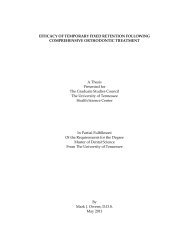BEVACIZUMAB EFFECT ON TOPOTECAN PHARMACOKINETICS ...
BEVACIZUMAB EFFECT ON TOPOTECAN PHARMACOKINETICS ...
BEVACIZUMAB EFFECT ON TOPOTECAN PHARMACOKINETICS ...
You also want an ePaper? Increase the reach of your titles
YUMPU automatically turns print PDFs into web optimized ePapers that Google loves.
ABSTRACT<br />
Increasing evidence suggests that inhibition of vascular endothelial growth factor<br />
(VEGF) can transiently normalize tumor vasculature, thereby improving delivery of<br />
systemic chemotherapy. Bevacizumab (BEV), an anti-VEGF antibody, has been shown<br />
to transiently normalize tumor vasculature by increasing tumor vessel maturity,<br />
decreasing tumor vessel permeability, and increasing tumor oxygenation in an Rh30<br />
orthotopic rhabdomyosarcoma xenograft model. However, the effects of BEV on the<br />
pharmacokinetics of TPT and the antitumor activity of TPT have not been evaluated. This<br />
study aimed to investigate the effect of BEV on TPT systemic and tumoral<br />
pharmacokinetics and to determine how these changes affect the efficacy of TPT in the<br />
Rh30 mouse model.<br />
Mice bearing Rh30 orthotopic xenografts were treated with BEV alone (5 mg/kg),<br />
TPT alone (2 mg/kg) or a combination of the two administered intravenously with<br />
different schedules. The pharmacokinetics of TPT, including TPT intratumoral<br />
penetration, as well as the efficacy of the monotherapy and combination therapy were<br />
evaluated. Population pharmacokinetic modeling and covariate analysis of TPT<br />
pharmacokinetics were performed using the maximal likelihood expectation<br />
maximization (MLEM) method in ADAPT 5 to predict the plasma and tumor<br />
concentration-time profile, to estimate the pharmacokinetic parameters of individual<br />
mouse and mice population, and to evaluate the effect of BEV on TPT systemic and<br />
tumoral pharmacokinetics. Tumor penetration was assessed by the tumor-to-plasma ratio<br />
of area under concentration-time curve (AUC). Tumor volume before and after the<br />
treatment were measured to evaluate the antitumor activity of the treatment regimen, and<br />
to assess the effect of BEV on the antitumor activity of TPT in Rh30 xenografts.<br />
Covariate analysis showed a single dose of BEV was associated with the<br />
increased systemic elimination rate and clearance of TPT. Furthermore, a single dose<br />
BEV had a time-dependent effect on the tumor elimination rate of TPT. The elimination<br />
rate of TPT from tumor compartment increased when it was given 1 day after a single<br />
dose of BEV and gradually decreased to control level when TPT was given 3 days and 7<br />
days after a single dose of BEV. Multiple doses of BEV had no effect on TPT<br />
pharmacokinetics. TPT penetration was not altered after administering multiple doses of<br />
BEV, but a single dose of BEV produced a trend in changes of TPT penetration. Tumor<br />
efficacy was not dependent on the schedule of BEV and TPT. TPT significantly enhanced<br />
the antitumor activity of combination therapy while pre-treatment of BEV did not alter<br />
the antitumor activity of TPT. Tumor efficacy in MDBT groups was mainly due to the<br />
multiple doses of BEV and the antitumor activity of TPT was diminished.<br />
The present work provides crucial insights into the effect of coadministration of<br />
BEV on the pharmacokinetic changes and antitumor activity of TPT. The increased TPT<br />
systemic elimination and clearance after single dose of BEV treatment may be due to the<br />
altered renal clearance by VEGF. The increased TPT elimination from tumor tissue after<br />
1 day pre-treatment of BEV may be caused by a normalization of tumor vasculature. The<br />
iv
















